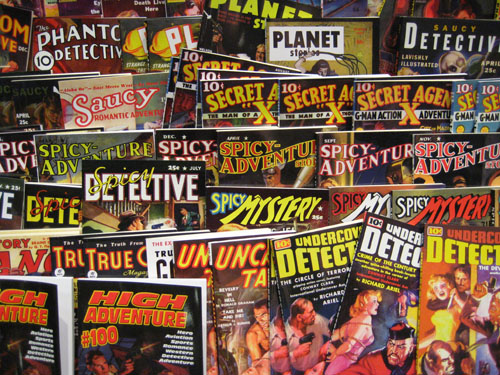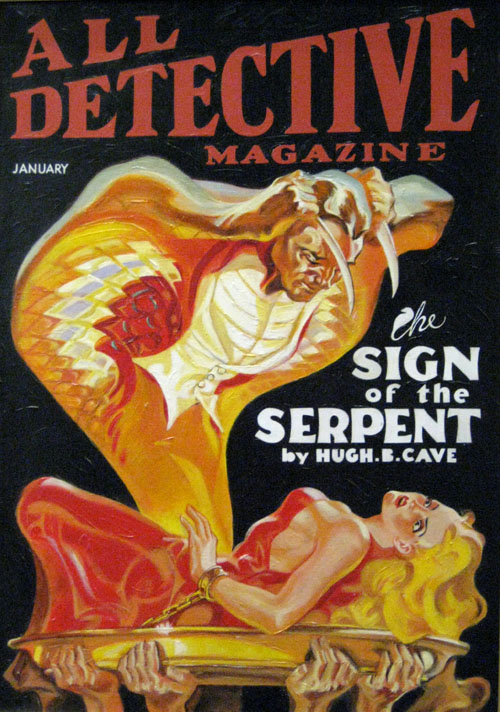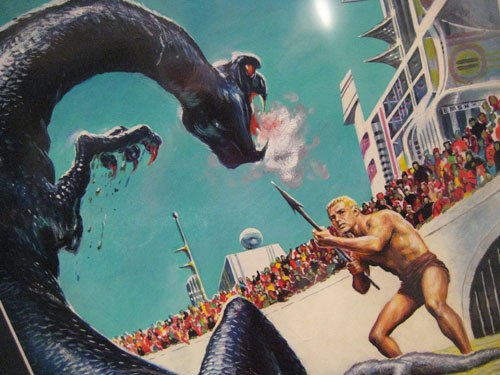When does an antiquarian become an antique? The question suggested itself when I attended the Windy City Pulp and Paper Convention recently. The convention is a haven for fans of the old pulps, cheaply printed magazines that flourished between the '20s and '50s by offering tales of adventure, horror, science fiction, mystery, the Wild west and other more obscure, indefinable genres for just a dime. During this publishing renaissance American icons like Doc Savage and the Shadow emerged, and writers like Raymond Chandler, Robert Heinlein, and H. P Lovecraft got their start. But by philosophy and design the pulps were never intended to be a permanent thing. Their popularity failed to survive the effects of World War II paper shortages and, toward the end, television. Eventually, the publishers stopped publishing, and pulps were left to molder in the nation’s garages, attics, and city dumps.
But the fans persevered — collecting, preserving and trading the magazines to this day. Unlike comic book collectors and other fandoms, pulp fans are a graying breed, leaving relative youngsters like convention founder Doug Ellis, 44, to promote them to a new generation. Tall, lean and bespectacled, Ellis was a figure in constant motion, racing from table to table and art room to auction block for two hours before sitting for an interview. Commercial real estate lawyer by day/avid pulp collector by night, Ellis discovered the pulps in his teens via the gateway drug of science fiction. In time, paperback reprints of the old Doc Savage and Shadow stories caught his eye.
"Unlike most kids I read the copyright pages. I'd see that these stories appeared in such-and-such magazine from 1935 or '36. So, I knew that there were magazines out there from 50 to 60 years ago that ran the type of material I liked to read, but didn't really know what they were."

Enlightenment came at a garage sale, where the 15-year-old Ellis discovered a stack of pulps for sale. In 1978 his name ended up on a mailing list for Echoes, a pulp fanzine. He subscribed, and soon he was in touch with other fans. Consequently, both his collection and interest grew, and in 2001 Ellis started the Windy City Pulp and Paper Convention with a friend. He now runs the show with Adventure House founder John Gunnison. Only eight years old, the convention is a youngling beside similar gatherings like Pulpcon, now in its 37th year.
The Windy City Pulp and Paper Convention does well enough. The Chicago area has a respectable pulp pedigree as the birthplace of writers like Edgar Rice Burroughs (creator of Tarzan and John Carter, Warlord of Mars), publishers like Ziff-Davis, and influential magazines such as the horror/fantasy pulp Weird Tales. The Midwest provides a ready corps of fans too, though Ellis recognizes that his convention doesn't pull in the hordes the comic and science fiction cons do. "We currently get just over 400 attendees, and of those probably 60 percent are from the Chicago area or within a couple hours drive of Chicago."
Local author and pulp scholar Robert Weinberg remembers the first-ever pulp convention as a "wonderful time." (Full disclosure: During college, I worked as a clerk for Weinberg and his wife Phyllis when they sold scifi, fantasy, horror and other books out of their house. Nirvana for this young geek.) Weinberg is quite the eminence grise with his silver-grey hair, trim beard and an impressively hefty walking stick decorated with an Egyptian ankh. At 61, he recalls being one of the "kids" in the room at the first Pulpcon, the brainchild of a group of scifi fans with a special affection for the pulps. Science fiction conventions had been held since the 1930s, but the pulp fans began to feel "left out." True, many pulps ran scifi stories, but in the increasingly formalized atmosphere of the conventions, stories about two-fisted detectives, jungle adventurers, extra-dimensional gods of chthonic evil, and the like were personae non grata. In 1972, pulp collectors Fred Cook, Lynn Hickman, Lester Mayer, Ed Kessel and Rusty Hevelin held the first PulpCon in St. Louis. Some 100 folks attended, and guest speakers included definitive Shadow cover artist Graves Gladney and pulp writer Edmond Hamilton, much older but willing to talk about the dime magazine days. A good time was had by all.
Such bonhomie continues at the Windy City Pulp and Paper Convention, explains Weinberg. "If you say 'Cornell Woolrich' in the elevator with five other people going up to the 18th floor, three of them will go, 'Oh, you know what my favorite Cornell Woolrich story is?"

Pulp magazines spanned many genres, sometimes as dissimilar as spy novels and soppy tales of romance. I ask if there's any infighting between, say, the detective fans and the horror buffs.
"No, everybody has their own madness," says Weinberg. The running gag is to declare its depth to your fellow collectors. "'Oh, I have 5,000 pulps, I'm the most crazy person in the world, my wife tells me that all the time!' And somebody else will go, 'Are you nuts!? I have 10,000 pulps. It fills up my basement and my garage and my wife has been beating me on the head for 15 years to get rid of this stuff!'"
Long-suffering spouses aside, pulp madness is infectious. Walking about the show, beholding all those ingloriously crumbling magazines en masse caused my sense of reality to slip a bit. Lurid, luscious, often ludicrous covers slapped my eyeballs left and right with image after image of masked men, anvil-chinned shamuses with gigantic guns, rampaging robots, bug-eyed aliens, multiple variations on the Grim Reaper, and all manners of evil ne’er-do-wells, vicious beasties and sinister foreigners placing barely dressed women in terrible peril. It's like standing in a Japanese candy store. The colors and designs of the wrappers are exciting and inviting, and I'm both tempted and a tiny bit afraid to take a bite.
The prices of original pulps curbed my appetite somewhat. Random flippings through the dealer room racks revealed that buying a copy of an original hero pulp like The Spider, or a saucy title like (ooh-la-la!) Spicy Adventure Stories might effect my ability to pay this month’s gas and electric bills. Publishers like Girasol Collectables, Nostalgia Ventures, and Gunnison's Adventure House come to the rescue through trade paperback reprints and, more interestingly, pulp replicas — complete reproductions of the original magazines right down to the ads for trusses, nose-straighteners and cures for piles.

Walking on, I overheard a dozen conversations held between excited men thrilled to speak with people not sick of hearing about those goddamned magazines all the time. They are, with rare variation, white guys — lightly to heavily wrinkled, a touch grizzled, perhaps balding, mayhap a bit paunchy, but ever youthful in the way they chatter away about pulp stories, pulp heroes, pulp covers, pulp writers, pulp artists, pulp radio shows, and the like. Boyish glee fills these middle-aged to elderly faces as they drop the names of "Doc," the Shadow, Secret Agent X, the Phantom Detective, G-8 and His Battle Aces, Operator #5, the Spider, the Avenger, and even more obscure heroes. In a roundabout way, the con's guest of honor, writer and pulp expert Will Murray, 55, explained the pulps' general appeal to me while discussing his favorite subject, Doc Savage. "Doc was originally written for the 15-year-old of all ages."
The level of obsession present is magnificently terrifying. After 75 years of pulp scholarship, every cavern and cubbyhole has apparently been explored and gleaned for the most infinitesimal facts and figures. Books discussing every aspect and nuance of the work of Robert E. Howard (Conan the Barbarian), Lester Dent (Doc Savage), or H.P. Lovecraft (writer of the Cthulhu mythos) abound. One attendee pitched me a CD-ROM crammed with a thousand or more covers — "For research purposes," he explained. Another touted The Compleat Adventures of the Moon-Man carefully explaining that the Moon-Man was not in fact from la Luna, but instead a Robin Hood-type thief who robs from rich criminals and gives to the poor while wearing a black cape and a fishbowl helmet made of one-way glass. Moon-Man's adventures come in a handsome two-volume hardcover set for $180. You might laugh, but I can't say I wasn't tempted to splurge on something that sounded so exquisitely insane. Geeky? Oh, hell yeah. On the other hand, no one there was dressed as a Klingon.

The number of pulp fans hasn't increased dramatically since those 100 fans at the first PulpCon. With the exception of a couple of teen boys, an occasional kidling tagging along with granddad, and one bored-looking young blonde yawning while her significant male other rifled through the racks, I noted mostly male devotees on the far side of middle-age.
"The average age is 40 or 45 and going up. There’s not a lot of younger collectors involved anymore in the field. It's hard to discover what pulps are all about," says Robert Weinberg.
Doug Ellis has faith in another publishing renaissance — the Internet. Whereas fanzines and auction catalogs came out monthly at best back in the '70s, online forums allow for year-round virtual pulp shows. He also cites the great historical preservation society that is eBay in saving pulps from the trash heap.
"Before, if someone was cleaning out a house and they found these old magazines, they more likely than not just threw them away. Now, with eBay, people have a sense that 'I don't know what it's worth, but I know it's worth something.'"
Maybe it’s a phonetic issue. The word "pulp" is an unpleasant one, falling on the ears with a wet splat like "moist" or "smut." Maybe it’s because the negative connotation of "pulp fiction" outlived its source. Quentin Tarantino's Pulp Fiction was both a blessing and curse, raising awareness of the pulps while underscoring their reputation as lowest common denominator fiction that pours on the sex and violence (Trivia: The working title for the film was Black Mask, one of the great pulps, published by, of all people, H.L. Mencken). The penny a word the original writers were paid suggests equally low-rent writing. Well, sometimes, but Weinberg pooh-poohs painting all pulps with the same sleazy brush.
"Actually, pulps were reasonably well-written, but they've gotten the reputation of being cheaply written. If you read a novel from the 1930s... just a mainstream novel by somebody, and then you read a pulp novel, chances are better you'll like the pulp novel."
All is not lost though. A silent majority, absent from the Windy City Pulp and Paper Convention, unknowingly carries the pulp standard.
"There's probably 500, 600 hardcore, dedicated collectors in the whole country, but there's literally thousands upon thousands of people who don't think of themselves as being pulp collectors, but who love work by Raymond Chandler or Dashiell Hammett or Cornell Woolrich... So, there are a lot of people who like the old pulp-type fiction. They just don't realize that's what they like." ✶





